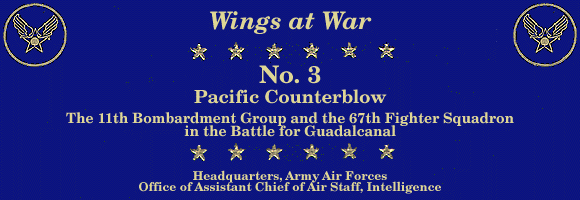

Pearl Harbor secured for the Japanese the initiative in the Pacific. They chose first to strike southward. By March 1942 the Netherlands East Indies, and with them any opportunity of reinforcing the Philippines, had largely disappeared in the maw of Nippon's war machine. March and April a successful but less precipitate foe devoted to the initial digestion of his gains and the extension of his forces along the flanks of Australia. Already Australian security had thus become the first charge of U. S. forces in the South Pacific, and defense of Australia meant defense of the last remaining reinforcement route to the subcontinent--the 7,000 miles of island-studded Pacific seas lying between San Francisco and Sydney. Chapter 1: The South Pacific, Summer 1942
Twice more the enemy moved offensively. A thrust in early May against either Port Moresby, New Guinea, or the Free French isle of New Caledonia, bastion of the supply route from the United States, was smashed in the Coral Sea. And after 6 June, with its ambitious two-pronged offensive against Midway Island and the Aleutians crushed at Midway, the Japanese fleet retired westward to lick its wounds. For the first time in the Pacific war, America possessed the initiative--a limited, precarious initiative, demanding the earliest possible exploitation.
How this initiative was employed is the history of the operation against Guadalcanal and Tulagi in the Solomon Islands. Primarily it was an operation to safeguard Australia's supply line, threatened
first from Rabaul, secured by the enemy in January; then from Tulagi, where by May the Japanese were already well established. (It was at Tulagi Island that the Yorktown's aircraft carried out a successful strike during the Battle of the Coral Sea.)In June grass was burning on Guadalcanal's Lunga Plain, one of the few spots in the Solomons where an airdrome could easily be built. Around 4 July, Japanese troops and construction personnel moved ashore and in less than a month Allied search planes saw the first signs of what appeared to be a concrete runway.
The Tulagi-Lunga Plain combination was extremely convenient. Enclosed by the small islands of Tulagi, Gavutu, and Tanambogo, the harbor on Tulagi is deep and spacious; with air cover from Guadalcanal it presents an excellent naval base site. Backing this advanced base were Rabaul, only 565 nautical miles distant; Bougainville, with the important Buin-Faisi-Tonolei complex, protected from Kahili Field, at it's southern tip; Kieta, where an airdrome was already being laid out--an impressive array of supporting bases. And from many lesser bases in the Solomons--from Gizo, Rekata Bay, Kieta and Buka Passage--seaplanes were already operating.
With Lunga airdrome complete, land-based bombers would be able to soften the New Hebrides for a thrust southward. If the Japanese were to be stopped short of a point where they could snap the lifeline to Australia, then Tulagi-Guadalcanal offered the last possible opportunity.
The man facing this problem was Vice Adm.1 Robert L. Ghormley, Commander, COMSOPAC. As Commander, South Pacific Area,. Admiral Ghormley commanded all U.S. ground, air, and naval forces in his area, and certain New Zealand units as well. His air commander was Rear Adm. John S. McCain, who, as COMAIRSOPAC, controlled all land-based aircraft in the South Pacific Area, including those of the USAAF.
Top Army commander in the South Pacific was Maj. Gen. Millard F. Harmon, who arrived in the theater to assume the title of COMGENSOPAC, Commanding General, United States Army Forces in the South Pacific Area, only a week before the Guadalcanal offensive opened. Subordinate to COMSOPAC, General Harmon General Harmon Takes Over
was charged with the training and administration of all U.S. Army ground and air force troops in the South Pacific. His advent clarified the supply and administration of the string of island bases and lessened any possibility of Army units disintegrating organically under local Navy, Marine, or New Zealand control.General Harmon had stepped directly from the post of Chief of the Air Staff. Moreover, the small staff which flew down with him to Noumea in the last week of July numbered such officers as Brig. Gen. Nathan F. Twining, future commander of the Thirteenth and Fifteenth Air Forces ; Lt. Col. Dean C. Strother, future commander of the Thirteenth's fighters; and Col. Frank Everest who was to command its bombers.. If Admiral McCain retained operational control of Air Corps units, he recognized that the wide dispersion and dissimilar composition of his air establishment made it impracticable to exercise his command directly. Training and a certain amount of tactical discretion remained to COMGENSOPAC and his subordinate commanders.
In July the Army Air Forces were mainly represented in the forward area by the 11th Bombardment Group (Heavy) and the 67th Fighter Squadron. The former disposed of 27 B-17s on New Caledonia and 8 at Nandi in the Fijis. The 67th mustered 38 P-39s and P-400s, all on New Caledonia. The P-400, to quote the men who flew it, was "a cheap version of the early P-39s." Additionally, there were on New Caledonia 10 B-26s with a dozen more in the Fijis.
Table of Contents ** Previous Chapter * (Foreword) Next Chapter (2)
[1] The ranks of officers mentioned in this booklet are those which they held at the time of the events described herein. Footnotes